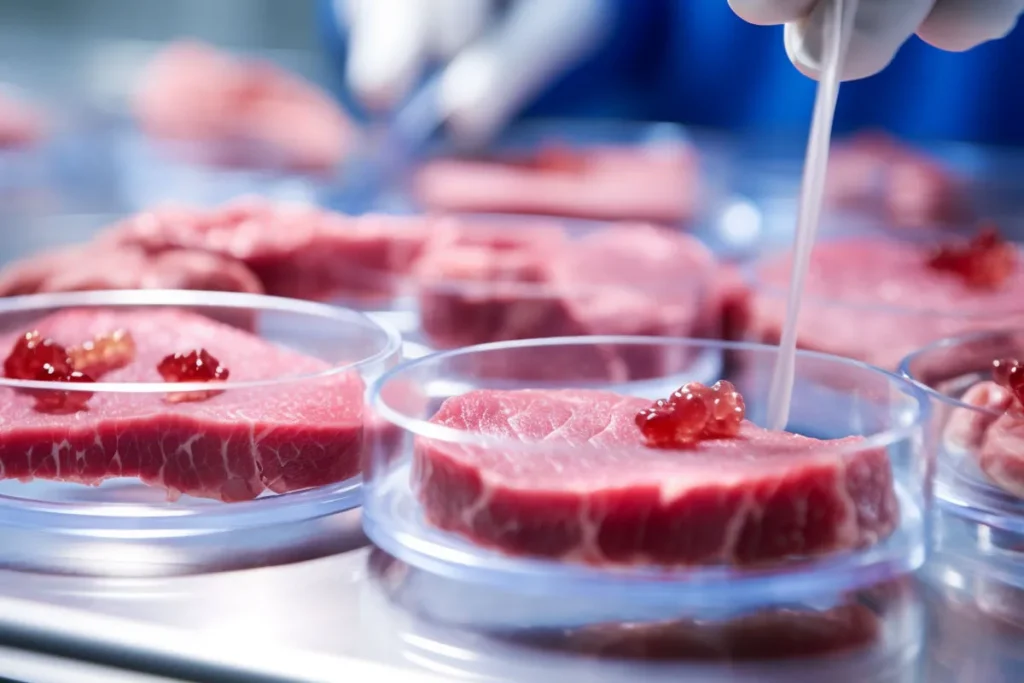Table of Contents
The concept of futuristic food encompasses innovative approaches to how we produce, consume, and think about food. As technology advances and environmental concerns become more pressing, the food industry is evolving to meet new demands for sustainability, health, and efficiency. This article explores the trends and technologies shaping the future of food, from lab-grown meat to plant-based alternatives, and their potential impact on our lives.

1. Lab-Grown Meat: The New Frontier
Lab-grown meat, also known as cultured or cell-based meat, represents a significant leap forward in food technology. This innovative approach involves cultivating meat directly from animal cells without the need for traditional livestock farming. The process starts with taking a small sample of animal cells, which are then cultured in a lab to grow into muscle tissue. The result is a product that closely mimics conventional meat but is produced in a more sustainable and ethical manner.
- Sustainability: Cultured meat has the potential to reduce the environmental impact of meat production significantly. It requires less land, water, and energy compared to traditional livestock farming and generates fewer greenhouse gases.
- Ethical Considerations: By eliminating the need for raising and slaughtering animals, lab-grown meat addresses ethical concerns associated with animal welfare and factory farming.
- Health Benefits: Cultured meat can be engineered to have a more favorable nutritional profile, with reduced fat content and no antibiotics or hormones.
2. Plant-Based Alternatives: A Taste of Tomorrow
Plant-based foods are becoming increasingly popular as consumers seek healthier and more sustainable dietary options. Advances in food technology have led to the development of plant-based products that closely resemble meat in taste, texture, and appearance.
- Innovative Ingredients: Companies are using ingredients like pea protein, soy, and jackfruit to create plant-based burgers, sausages, and even seafood. These ingredients are processed and combined to mimic the sensory qualities of animal-based products.
- Environmental Impact: Plant-based foods generally have a lower carbon footprint and require fewer resources compared to animal-based foods. They contribute to reduced deforestation, water usage, and greenhouse gas emissions.
- Nutritional Value: Many plant-based products are fortified with vitamins and minerals to ensure they meet nutritional needs. They also provide an opportunity to include more fiber and phytonutrients in the diet.
3. Insect Protein: An Alternative Protein Source
Insect protein is gaining attention as a sustainable and nutritious alternative to traditional animal proteins. Insects like crickets, mealworms, and locusts are rich in protein, vitamins, and minerals, making them a viable option for addressing global food security.
- Sustainability: Insects have a low environmental impact compared to livestock. They require less feed, water, and land, and produce fewer greenhouse gases.
- Culinary Applications: Insects can be used in various food products, including protein bars, snacks, and even flour for baking. Their versatility allows for creative incorporation into different cuisines.
- Cultural Acceptance: While insect consumption is common in some cultures, its widespread acceptance in Western countries may require changes in perception and education about the benefits of insect protein.

4. Vertical Farming: Growing Food in Urban Spaces
Vertical farming is an innovative approach to agriculture that involves growing crops in stacked layers or vertical structures, often within urban environments. This method utilizes controlled environments, such as hydroponics or aeroponics, to optimize plant growth and resource use.
- Space Efficiency: Vertical farming maximizes land use by growing crops vertically rather than horizontally. This is particularly beneficial in densely populated urban areas where space is limited.
- Resource Management: Vertical farms use less water and fertilizers compared to traditional farming methods. The controlled environment also reduces the need for pesticides and herbicides.
- Local Food Production: By producing food closer to where it is consumed, vertical farming can reduce transportation costs and carbon emissions associated with food distribution.
5. Personalized Nutrition: Tailoring Diets to Individual Needs
Advances in genetic testing and data analytics are paving the way for personalized nutrition, where diets are tailored to an individual’s genetic makeup, lifestyle, and health goals. This approach aims to optimize health outcomes and prevent chronic diseases.
- Genetic Insights: Personalized nutrition uses genetic information to identify dietary needs and sensitivities. For example, genetic testing can reveal how an individual metabolizes certain nutrients or responds to specific foods.
- Customized Diet Plans: Based on genetic data, personalized nutrition services can create customized meal plans and supplement recommendations to address specific health concerns and dietary preferences.
- Health Benefits: Tailoring diets to individual needs can improve overall health, enhance performance, and reduce the risk of chronic diseases such as diabetes and heart disease.
6. Food Printing: The Future of Culinary Creativity
Food printing, also known as 3D food printing, is an emerging technology that allows for the creation of intricate food designs using edible ingredients. This technology has the potential to revolutionize food production and customization.
- Precision and Creativity: 3D food printers can create complex shapes and designs with precise control over ingredients and textures. This allows for innovative culinary creations and personalized food experiences.
- Customization: Food printing enables customization of recipes and dietary needs, including creating dishes that cater to specific nutritional requirements or aesthetic preferences.
- Sustainability: The technology also has potential applications in reducing food waste by using surplus or underutilized ingredients in creative ways.

7. Conclusion
Futuristic food represents a dynamic and rapidly evolving field that combines technology, sustainability, and innovation to address the challenges of modern food production and consumption. From lab-grown meat and plant-based alternatives to insect protein and vertical farming, these advancements hold the promise of transforming how we think about and interact with food. As we continue to explore and develop these technologies, the future of food offers exciting possibilities for improving health, sustainability, and culinary creativity.
